100 Ways to Reduce Food Waste
With looming food shortages due to war and the pollution generated from the global food industry, it’s time to find ways to reduce food waste.
No one should have to endure food insecurity especially when supermarkets dump tons of food products that have arbitrary best before dates slapped onto them.
It’s time that we all do our part. So, I’ve added about 100 ways to reduce food waste. Hopefully, you can find a couple new ways to implement today.
As an Amazon Associate, this site earns from qualifying purchases.

Ways to Reduce Food Waste
#1. Check your trash
What’s in your trash? Leftovers? Moldy fruits and veggies? Make a mental note of what you throw away the most. Keep a trash journal if you need to so you can figure out how to adjust your habits. Making smaller meals or freezing more produce could help to lighten your trash.
#2. Plan your meals
Plan your meals for the week. You don’t have to be rigid. But a general plan will help you use what you already have in the pantry, fridge and freezer. Get a notebook for your plans (I love this weekly meal planner from Amazon). At the end of the week, review everything. Make little notes of what you stuck to, what worked, and what didn’t.
#3. Plan for the scraps
While meal planning, think about what you can do with the leftover food. For instance, after deboning a chicken, you can use the carcass to make chicken stock. Bones and veggie scraps are great for making stock too. Explore root-to-stem and nose-to-tail cooking. Dana Gunders’ Waste Free Kitchen Handbook is a great resource for this.
#4. Get organic food
If you plan to use your scraps, it’s important to use organic food. They contain less pesticides, weedicides (like glyphosate), synthetic additives, antibiotics, growth hormones, and more. You don’t want any of that in your food.
#5. Go plant-based, sometimes
Raising livestock requires a lot of land and forest clearing. If that wasn’t bad enough, the industry generates significant air pollution that contributes to global warming. And to produce enough food to feed the world by 2050, the UN FAO recommends having a more sustainable diet by replacing meat with peas, and beans.
If you aren’t ready to give up meat, that’s okay! Start small by swapping out meat in one meal per week and work your way towards the right balance for you.
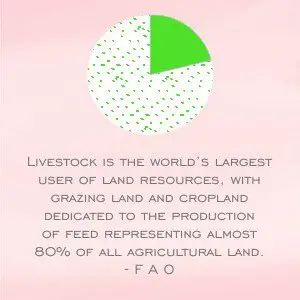
#6. Check your pantry before shopping
I’m guilty of buying food I completely forgot I had. Am I the only one? Before heading to the store, take a quick peek in your pantry, fridge and freezer. In that way, you won’t overbuy food. Another good habit is to check the expiry dates of what you have. Set up a little gotta–eat–this–soon area in your pantry to make sure you waste less.
#7. Buy what you actually need
With plans for meals and scraps, make a shopping list. Stick to it as much as you can since buying less usually means wasting less food.
#8. Or buy in bulk and share
Buying in bulk has its advantages. It’s cost-effective and reduces the amount of packaging you throw out (especially plastics). But the food can spoil on you. When buying in bulk, consider dividing food into portions and freezing what you won’t use within a week or two. Or try sharing portions with family or friends.
#9. Find nearby zero-waste or bulk stores
These stores are popping up everywhere. They usually sell products without plastic packaging. Bringing your own reusable bags and jars are almost mandatory. At bulk stores, you can get how much you actually need to make your meals. No waste here! Pick up pasta, loose tea, beans, oil, vinegar and even soap.
#10. Support farmers’ markets
The farmers’ market is my happy place. The sellers are always so willing to share useful tips, tricks and even recipes. And they have the freshest fruits and veggies perfectly arranged without plastic packaging.
Buy the amount of produce you need. And pick up eggs, honey, and homemade goods like cheese, oil, jam, wine, bread and pastries. For bonus points, take your reusable bags and bottles with you. Oh and produce delivery services that partner with local farmers are also gaining popularity. Look for them in your area. They usually send you fresh produce every week without plastic wrapping. Yay!
#11. Set up a garden
You can try your luck at growing fruits, veggies and herbs. Pick them only when you need to. No more sad, wilted, spoiled herbs and produce for you! No more plastic packaging either! That’s a win-win. Another win? Meals made with the freshest food always taste better!
Convinced? Then, check out your local plant nurseries and garden centers. Talk to the staff about everything from plant pots (clay ones are great) to soil mixes, organic fertilizers and natural insecticides. They’ll also have great advice on which seedlings to plant at what time of the year.
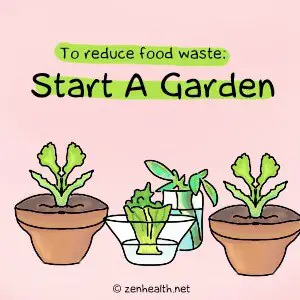
#12. Share what’s in your garden
When you get the hang of growing your own food, share the excess. Give your neighbors, friends and relatives. Donate to those less fortunate. Or set up a sharing nook in your building or neighborhood and encourage passersby to help themselves.
#13. Convince others to garden and share
My mom always had a kitchen garden… my mother-in-law too. So whenever we visit, they always send us home with their fruits and veggies. I return the favor and, with all the sharing, we need very little from the farmers’ market and supermarket.
So convince those closest to you to set up their own garden. Swap and share the harvest! Try bartering too. Homegrown produce also takes longer to spoil since they haven’t sat in a store for days.
#14. Grow food scraps as creative ways to reduce food waste
There are so many plants you can grow from food scraps. Don’t throw out lettuce, chives, bok choy, celery or mint scraps. Plant them instead. Basil, rosemary and thyme will grow if you pop their thicker branches in soil (did this a week ago!). Ginger, turmeric and garlic with tiny shoots will sprout and grow. The same will happen if you bury potato and sweet potato peelings with eyes. So try your luck!
#15. Save your seeds
Stop tossing seeds. Save them to plant later. I have done this so many times with tomatoes, watermelon, papaya, peppers, and more. Not every seed grows so plant a few in the same spot. If you end up with many seedlings, share them! Store the seeds in the fridge when you are not using them. Label them too and include their harvest date. And be sure to use older seeds first.
#16. Sprout your seeds
If your organic beans, pulses and grains have been sitting in your pantry for far too long, consider sprouting them. Mung bean and soybean sprouts are delicious. Here’s my simple guide on growing your own mung bean sprouts. You can also do this with fenugreek, quinoa, buckwheat, chickpeas, sunflower, broccoli, radish and spinach sprouts.
#17. Consider foraging and gleaning
So this one isn’t exactly about growing your own food… it’s more about picking it instead. Depending on where you live, you may be able to forage for weeds (like purslane), edible berries and wild fruits. Or gleaning may be an option. Anna explains it all in her post: 3 ways to get free organic food.
Gleaning and foraging are not encouraged in my country; they are considered theft and trespassing. So research the policies in your area to ensure you aren’t breaking the law.

#18. Set your fridge temperature
Set your fridge to a temperature below 40°F (4.5°C). Why? Because higher temperatures are perfect for pathogens to party in your food. And they can produce toxins that will most certainly spoil everything… and give you food poisoning. Let’s not have any of that!
Be sure to check your fridge’s digital temperature display. And use a regular thermometer in there (I use this one from Amazon) to verify the display readings.
#19. Set your freezer temperature
Your freezer temperature should be set to 0°F (-18°C). Food is safe indefinitely at this temperature, although freezer burn may happen which can affect the food’s color, taste and juiciness (but not its safety).
#20. Clean your fridge often
Bacteria and mold spores can circulate in your fridge and spoil food. So wipe up spills. Discard old, moldy food. And disinfect your fridge with a solution of one tablespoon of bleach mixed with one liter of water. Vinegar works too (try scrap vinegar from tip #87). Oh and use baking soda to remove terrible smells.
#21. Refrigerate animal products ASAP
Get meat, fish, and dairy products into the fridge as soon as you get home from the store to prevent them from going bad. Or portion them out and pop in the freezer.
Meat and fish can last many months in the freezer. Milk, cheese, and butter can be frozen too; although cheese dries and gets crumbly over time. That’s why I prefer to grate cheese before freezing.
#22. Store raw food lower
If raw meat or fish or liquefied lettuce leaks onto your cooked meals, throw the meals out. They’ll likely be contaminated and unsafe to eat. Instead, store cooked food on higher shelves above raw fruits, veggies, and especially meat.
#23. Cover food in the fridge
With mold and bacteria lurking in your fridge, store food in sealed or covered containers to prevent contamination. Dry any condensation on the inside of the cover too. Mold and bacteria love the moisture. If need be, try these reusable organic beeswax wraps from Amazon.
#24. Place new purchases behind
First in, first out for food. Say that five times fast, ha! New purchases should always be placed behind older ones. In that way, you’ll actually eat your older food and not leave it to spoil.
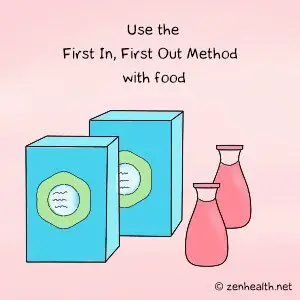
#25. Leave bread on the counter
Bread dries in the fridge so it’s better to leave it on the counter at room temperature. Soft bread will last three to four days. If you can’t finish it in that time, freeze it! Do the same for pastries. I’ve done this many times. They all stay really well.
#26. Allow produce to ripen on the counter
Keep fruits on the counter to ripen. Do this with mangoes, papayas, pineapples, tomatoes, avocados, bananas, and citrus. If you want to speed up the ripening process, put them in brown paper bags or wrap them in old newspapers. Once ripe, store them in the fridge. They’ll last a couple more days in there.
#27. Keep produce away from heat and ethylene gas
Heat also speeds up the ripening process. So keep your produce away from heat sources like your stove, toaster, or oven. Ethylene gas has the same effect. It is given off by a couple fruits like ripe bananas, apples, avocados and tomatoes. So keep them away from sensitive produce like broccoli, cabbage, eggplant, beans, lettuce, and more.
Activated charcoal can absorb some ethylene gas so place it next to produce on the counter and in your fridge. The charcoal absorbs odor too.
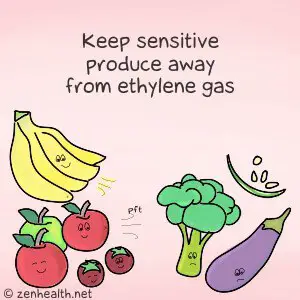
#28. Store potatoes, garlic and onions in the dark
Potatoes, garlic, and onions should be kept away from moisture, sunlight and heat. Store them in an open, low-lit spot or in a paper bag with holes. Potatoes and garlic can last for months in the pantry. Onions should be used within a month.
Also, keep potatoes away from onions. Onions produce ethylene gas which can cause the potatoes to spoil more quickly.
#29. Wash leafy greens first
So I started doing this recently and I’ve really noticed the difference. Run cold water over a head of lettuce or bok choy for a couple seconds, then shake off the excess. Place in the fridge in a bag or container and squeeze the air out. The leaves will stay perfectly crisp for a couple days. Rewash the leaves when you are ready to serve them and use within the week.
If you want your greens to last longer, leave them unwashed and place them in a vacuum sealed bag or container. They’ll survive for a couple weeks.
#30. Keep mushrooms dry to reduce food waste
Put mushrooms in a paper bag in the fridge to keep them dry. They can last up to 4 days in there. Double bagging them may buy you a couple more days. Mushrooms have short shelf-lives so use them soon after purchase. Visit the store during the week if you need to restock.
#31. Pop herbs in a glass of water
Arranging flowers in a vase with water keeps them from wilting. You can do the same thing for herbs in a glass of water. You could try growing your own herbs too (tip #11)! Store the glass in the fridge or on the counter. But be sure to change the water every day and don’t use the submerged parts.
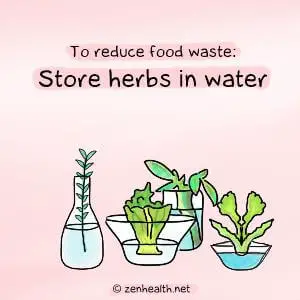
#32. Leave eggs in the carton
Don’t store eggs in the fridge door. It’s too warm for them there. Leave the eggs in the carton and place them on a shelf in the fridge. They can last up to five weeks in there.
#33. Prevent nuts from going bad
You can buy large amounts of almonds, peanuts and more. But if you don’t store them properly, they’ll become rancid. To prevent this, dry roast them and remove their outer shell. Keep them in the fridge in a sealed container. They’ll last for months. For raw nuts, freeze them!
#34. Refrigerate nut and seed milk and flour
Place nut and seed flours in the fridge too. And freeze homemade nut and seed milks in portions since they can become rancid. I do this with my homemade coconut milk (actually I’ve frozen whole coconut pieces too!).
#35. Put oils in the dark
Keep your oils away from the stove. Protect them from oxygen, sunlight, heat and moisture. Otherwise, they may also become rancid.
Store them in a cool, dark cupboard or in the fridge. I keep my homemade coconut oil in the fridge until I’m ready to use it. It usually lasts for many, many months in the fridge and about three months on the counter (it’s hot here!).
#36. Seal non-perishables
Stock grains and pulses in solid containers (like glass) with proper seals. Keep moisture and bugs from getting in and contaminating your food. Thin plastic bags can allow moths and weevil to get in and breed (that’s what happened to my brownie mix).
My aunt also freezes her grains and pulses. I’ve never tried to; but she swears by it. Be sure to label the dates on everything if you decide to freeze them. And use the first in, first out method (tip #24).
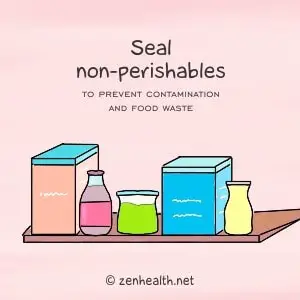
#37. Ward off bugs
Besides storing your food in sealed containers, use natural repellents in your pantry and on the counter top. In the Caribbean, we use West Indian bay leaves in cupboards to keep ants and bugs out. I use the leaves to make bay leaf tea as well. Essential oils also work. Lemongrass and citronella oils have very good repellent properties.
#38. Keep air away from food
Bacteria and mold in your fridge need moisture and oxygen to survive and thrive. So keep food dry. And squeeze the air out of your food bags as much as you can. Vacuum seals really do keep food fresher for longer.
#39. Reduce freezer burn
Freezer burn causes brownish spots on frozen food. It happens when air is in contact with food and either dehydrates or oxidizes the surface. Ice crystals may form too. Besides the color change, the taste may be slightly affected; but the food is still safe to eat.
To reduce the burn, store frozen food in airtight or vacuum sealed containers. And date them so you’ll use older food first… You know the drill: the whole first in, first out shtick.
#40. Make smaller meals
When I looked at what I threw out (from tip #1), I found leftovers were a big part of my trash. So I started tweaking my recipes to make smaller meals. I used smaller pots to make soup, boiled less rice and halved my bread recipes. It’s that simple to reduce food waste.
#41. Cook together
Make cooking a fun activity for the family. Or date night with cocktails and sautés. The more often you cook, the less you’ll need to order takeout. And the lower your exposure to possible viral infections. Cooking with your family (even virtually) and with great party music is always fun and you might actually use all that produce sitting in your fridge.
#42. Share meals and fun times
If you have a lot of ingredients in the gotta–eat–this–soon area of your pantry (from tip #6), whip up something special and share it with your nearest and dearest. Host fun get-togethers and send your guests home with extra food. They can return the favor too. Don’t forget to ask them to bring their own reusable takeaway containers.
#43. Try batch cooking
When you’re in that cooking mood, why not go all out and make large batches of food? Use those nearly expired goods or produce that has seen better days. Let the cooked food cool down before storing small portions in the fridge. Freeze the rest.
You can do this with stews, curries, muffins, and even bread. I’ve done this with everything from chocolate chip cookies to bread. They come in so handy on those lazy days!

#44. Cook foods with shorter shelf-lives first
Some foods spoil much faster than others. Mushrooms come to mind! So it is best to cook them first and earlier in the week. In the Caribbean, we use lots of starchy veggies like yam, taro, cassava and breadfruit. Yam can stay for months on the shelf. But the others discolor, soften and spoil within a day or two. So, to reduce food waste, I try to cook them on the same day of purchase (and freeze the excess).
#45. Understand expiration dates
This is a true story: hubby works for a beverage company. He says expiration dates are a lot more arbitrary than people think. Products due for export are slapped with a best-before-date one year after production. The same EXACT products due for the local market are given six months.
Why? He has no idea… The local products are usually sold out way before the six month mark anyway with no complaints…
So treat the expiration date on your food as a rough estimate. Using it a couple days before or after won’t change anything. But use your senses – if it looks unsightly or smells bad, don’t eat it.
#46. Eat leftovers
Commit to eating your leftovers within a day or two. Pencil in an Eat Leftovers Day when meal planning (you know from tip #2). Or pencil in two days! If it’s not possible to eat everything, consider freezing your leftovers.

#47. Or repurpose them
Leftover green beans? Mix them into your omelette or frittata. Leftover meat? Make quick and easy kabobs with BBQ sauce. Yum! Leftover rice? Use it to make a simple fried rice with sautéed veggies and soy sauce. There is no limit to repurposing leftovers that haven’t spoiled yet.
Hugh Fearnley-Whittingstall’s book, “Love Your Leftovers” on Amazon, has so many incredible ideas, recipes and tips you’ll love.
#48. Throw together a salad
There are no rules when it comes to making a salad. Throw your fruits, veggies, nuts, seeds, pulses, grains, meat and leftovers together. Mix in a little dressing, salt and pepper and pat yourself on the back for eating healthy and not wasting food.
Pick up Georgeanne Brennan’s cookbook with 365 salad recipes on Amazon.
#49. Drop wilted veggies in an ice bath
If your veggies are dehydrated and not salad perfect, try adding them to an ice bath. Cut them up and leave them in there for about 15 to 20 minutes. Let osmosis do its work and they’ll return to their crisp, happy selves. Try this tip with carrots, leafy veggies, sweet peppers and more.
Oh and if you grow your own veggies, they take a lot longer to wilt!
#50. Top pizza with extra meat and veggies
You can get your kids to eat just about anything if it’s a pizza topping. It works in my home. Before your produce or meat goes bad, whip up a homemade pizza with everything on top. I use a lot of herbs and veggies this way – and there are zero complaints about eating veggies. Haha!
#51. Make soup
I’m guilty of throwing everything into soup. It’s such a versatile dish. You can use up all your produce, herbs, meats and pulses. No food waste here!
Get ideas from The Soup Book on Amazon. It breaks down 200 soup recipes according to season, explains how to make broth with scraps, and even has a couple bread recipes in there.
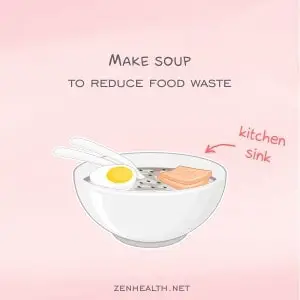
#52. Love your stale bread
Speaking of bread, don’t toss it when it’s stale. Nope! Try Vijaya’s trick for making stale bread great again … I mean soft again… Give it a grow’s video is also a must watch. He explains how to make croutons, bread pudding and French toast using stale bread.
#53. Use the leaves
Did you know tendergreens, broccoli leaves and beet greens are among the top 50 food sources of Vitamin C? It’s true! So rather than throwing out leaves, look for recipes to use them in!
Try Anna’s cream of broccoli leaf soup or her radish top pesto recipe. Brooke’s sautéed beet greens recipe and Lemon Mom’s minty carrot top pesto are also delish! Pinterest has tons more amazing recipes.
#54. Chips anyone?
Leaves can also be made into chips. Just mix them with a little oil and salt. And pop in the oven at 225°F for 30 minutes, turning once at the 15 minute mark.
Peels are also great – especially carrot peels and potato skins. If they’re organic, consider frying them in oil for a couple minutes. Add a little salt and pepper to taste. Yum!
#55. Turn peels into candy
Peels – especially citrus peels – make delightful candied treats! Orange, grapefruit and lemon peels are perfect to use here. Check out Erin’s candied orange peel recipe. She and her friend, Carrie, really explain how it’s made. And Amy gets into how to make candied watermelon rind!
#56. Keep the seeds
Besides saving your seeds to plant (tip #15), turn edible ones into snacks and sweet treats. Laura’s homemade cinnamon sugar pumpkin seeds recipe is lovely. And you can also use squash seeds too.
#57. Make your own oil
Use the seeds to make your own homemade oil too. But I suggest getting an oil press like this one from Amazon. Grind sunflower seeds, flaxseeds and sesame seeds into oil. It works great with nuts too like peanuts and walnuts. Can you imagine making your own fresh flaxseed oil? Or sesame oil? Yum!
#58. Attempt homemade dairy-free milk
For a more plant-based diet (from tip #5), consider making your own homemade dairy-free milk. Attempt small batches so you never waste. Or do large batches and freeze them in usable portions.
I make my own coconut milk and the extras usually end up in an ice tray. The cubes are perfect additions to Caribbean dishes. I’ve also made small batches of almond, cashew, and oat milk too. They’re great and all … but coconut milk is my favorite!
#59. And try homemade cheese and butter
Got milk that’s about to go bad? If it’s whole milk, then try Sweet Adjeley’s simple homemade mozzarella recipe from YouTube (P.S. this won’t work with pasteurized milk). Or make my paneer recipe. It’s an Indian cottage cheese that you can add to curries, masalas, and more.
If you have nuts or nut milk that have been sitting in the fridge for too long, then work your way through Christina’s easy nut cheese recipe and Alyssa’s nut butter recipes on Youtube.

#60. Save the liquid
Keep the leftover liquid (or whey) from cheese making. Use it in Melanie’s whey pancakes and Paula’s easy whey bread. Lisa’s whey caramel (video) is also a sweet treat you can try.
Besides whey, keep your aquafaba (the liquid that comes in the can of chickpeas). It’s a great egg substitute. Check out how Camilla used it to make her vegan apple meringue. Delicious!
#61. Whip up some smoothies
Smoothies are the perfect way to use all your fruits, veggies, nuts, milks and seeds and reduce food waste. You can really pack a lot of nutrition into one glass. Oh and you can make a couple smoothies for the week and freeze them. Pop them in the fridge the night before to defrost and enjoy the vitamin filled drink in the morning. What a way to start the day!?!
#62. Flavored water?
Skip the blender and add fruits directly to your water. Finish your lemons, cucumbers, and berries this way. Pineapple, watermelon and herbs like spearmint are also great additions.
#63. Prepare popsicles
I am the biggest fan of popsicles, probably because the Caribbean has popsicle weather all day, every day. I make guava pine and watermelon berry popsicles often. But you can use any fruit and veggie combo you like. And use up your coconut water, milk and juice as the base… We aren’t going to waste drinks either.
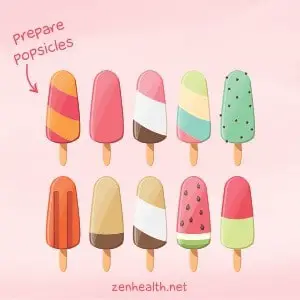
#64. Use the pulp
There are so many ways to use pulp from your juices, smoothies, dairy-free milk, and oil! Becky has a wonderful recipe for juice pulp muffins. She uses carrot, pineapple, and orange pulp; but you can really use anything. Waffle & whisk has great combos too.
My mom adds coconut pulp to her bread recipes. I use nut and seed pulp to make a simple hummus with garlic, lemon juice, olive oil, tahini and seasoning. It’s a fun treat and a great way to reduce waste.
#65. And turn it into flour
Besides adding nut and seed pulp to hummus and baked goods, try making flour. I’ve found spreading the pulp on a cookie sheet and placing it in the blazing Caribbean sun for a couple hours dries everything out.
Otherwise, try baking in the oven at a low temperature (like 225°F) for an hour or two. You may want to mix the pulp often and use parchment paper if you think it’ll stick. Add to your food processor after for a finer consistency.
#66. Make granola
There’s never a wrong way to make your own granola. You can use up your nuts, seeds, grains, fruits, candied peels, and more. Mix whatever combination you like and add in vanilla, cinnamon, a sweetener and a little oil. Spread out on a cookie sheet and bake in low heat until firm (30 – 60 minutes).
#67. Work those brown bananas
I love, love, love brown bananas. I always make banana pancakes with them. And to be honest, I don’t use a recipe. I just squish the bananas, add some sugar, vanilla, an egg, and enough flour to give everything a flowy, pancake batter-like consistency. Then, it’s just to cook like regular pancakes.
There are so many more ways to use ripe bananas. Frozen slices work so well in smoothies. Banana bread is delicious! As for plantains, use them to make plantain bread!

#68. Learn how other cultures use food
Look at how other cuisines and cultures use food you usually throw out. Or how they reduce food waste. In the Caribbean, uncommon animal parts are widely used in soups and pickles. Pig tail, ox tail, cow heel, fish head and goat head soups are all popular. Pig’s feet, cow tongue, chicken feet, and pig tails are also used in souse (a type of pickle).
Animal blood is made into black pudding (a type of blood sausage). Sheep’s tripe, heart, liver and intestines are curried with seasonings to create pachownie. Scotland has haggis – a savory pudding that has sheep’s heart, liver, lungs, oatmeal and seasonings. And Uzbekistan has plov – a rice dish with meat and veggies.
What’s an interesting dish in your culture that uses unique ingredients? Share it in the comments!
#69. Explore zero-waste cooking
I’ve barely scratched the surface of cooking tips you can try to reduce food waste. There are just so many ways to experiment while cooking.
I mentioned in the planning for scraps tip (#3) that you should think about stem-to-root, nose-to-tail and fin-to-tail cooking. They fall under the umbrella of zero-waste cooking; something you should explore as you work towards reducing your waste.
Start with these two cookbooks from Amazon: Lindsay-Jean Hard’s Cooking with Scraps and Jill Lightner’s Scraps, Peels, and Stems. They are amazing!
#70. Discuss portion options with restaurant staff
Portion sizes at restaurants have ballooned over the years. If you’re like me, you could never finish an entire meal. So talk to the staff about smaller meal options. Or ask for additional plates and cutlery so you could share the meal among your dining party. Those dinner dates are usually more fun anyway, heh!
#71. Take leftovers home
If you aren’t able to eat everything at the restaurant, always ask for a doggy bag to take the leftovers home. They are perfect for lunch the next day. If I am not a fan of the meal, I usually feed it to my pupper. She’s always a fan of anything called food, ha!
Oh and it won’t hurt to ask the restaurant if you could pack the leftovers in your own reusable containers and bag. Explain you’re trying to use less plastic and reduce waste. They should be more than happy to comply.
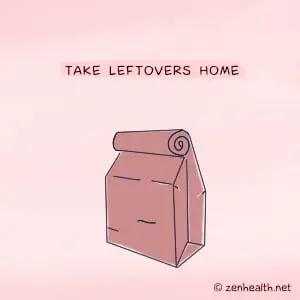
#72. Travel with reusable containers
Do you toss cold coffee when you’re on the go? Consider adding your drink to a thermal insulated bottle instead (I love the DuraFlask and Mira bottles on Amazon). Or take your bottles with you to the coffee shop and ask them to fill ‘er up! Some shops will give you a tiny discount too. Your coffee will stay hot for longer and you can enjoy it throughout the day.
You can do the same with leftover sandwiches and meals. And there are lots of thermal insulated containers or bags that you can keep your food in for later (I have this cutie from Amazon).
#73. Freeze when needed
From tip #19, you saw a freezer temperature of 0°F (-18°C) will keep food safe indefinitely. That’s why I turn to my freezer to reduce food waste.
I cut, cube, and juice seasonal tropical fruits and some veggies before freezing. Cooked food, grated cheese, whole tomatoes, limes and avocados are popped straight in there. But I do like cleaning and seasoning meats and fish before freezing … below the fruits and veggies, of course. And, apparently my aunt loves to freeze her grains and pulses (*I never knew we could do that!*).
Check out Lydia’s article for more ideas on which foods to freeze. Remember to label your food with the dates you placed them in the freezer. Use the first in, first out method to keep a good turnover in there. And don’t overstuff the freezer. Think about what’s in there when planning your meals (from tip #2).
#74. Donate
I mentioned in tip #12 to share and donate the extras of your garden. But I wanted to expand that point here to include extra food you may have in your pantry, freezer and get-togethers. Contact food banks, shelters, and other food rescue programs. Learn what their rules are when it comes to donating produce, meats, grains, pulses and even cooked food. Donate what you can.
#75. Whip up jams and jellies
Growing up, during guava season, my mom always made guava jam. Guavas are her favorite so she refused to waste any. We didn’t mind; guava jam is delish! Davorka has lots of recipes for making fruit jams, syrups, and curds. Rachel has interesting homemade jelly recipes too. You can use these recipes especially with seasonal fruits to reduce food waste.
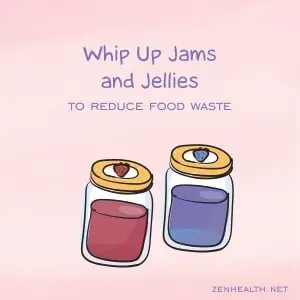
#76. Try chemical pickling
Pickling veggies and meat is pretty common throughout the world and there are a couple ways you can do it. Chemical pickling uses brine, vinegar, alcohol or vegetable oil to preserve food and inhibit microbes. Sometimes, heating is required so the pickling liquid gets into the food. Alyssa has a nice video on how to pickle veggies. And this book on Amazon is a great one to get: DIY Pickling: Step-By-Step Recipes for Fermented, Fresh, and Quick Pickles.
#77. Or ferment
With fermentation, bacteria in the food produce organic acids (usually lactic acid) which act as preservatives. Sauerkraut, kimchi and nukazuke are examples of fermented food.
Mike’s Youtube video is a great guide on fermenting food at home. I love Caitlin’s video on how to make sauerkraut too. It’s nice and easy to follow along. And JinJoo explains how to make kimchi on her blog.
#78. Get to canning
Canning involves processing food, sealing it in sterilized containers and boiling the containers to make them airtight and to sterilize everything. Canning is a great way to preserve food and reduce food waste.
Tomato salsa, apple pie filling, whole fruits and leafy greens are just some examples that can be canned. Heather from The Kneady Homesteader breaks down how to do water bath canning in her Youtube video. And for more advanced pressure canning methods, take a look at Prepper Potpourri’s video: pressure canning for beginners.
#79. Dehydrate food
Drying and dehydration is one of the oldest forms of preserving food. I usually spread excess fruit, veggies and herbs onto large trays and put them in the sun. But dehydrators work really well too. And if you keep dehydrated food away from moisture, they can last a couple months to years.
#80. Turn them into powder
When I harvested turmeric from my garden, my mom showed me how to make turmeric powder. She peeled and grated the rhizomes, spread the strands onto metal sheets and placed them in the blazing Caribbean sun to dry. Many hours later, the strands were crispy! She pulverized them in her coffee grinder and sifted them. The result? The purest, organic turmeric powder! The color was so vibrant and it smelled amazing!
Use a dehydrator or a convection oven on low heat to get the same drying effect. Besides a coffee grinder, you can use a mortar and pestle too.
Make your own homemade onion, garlic, ginger, pepper, kale, moringa, veggie and berry powders. Elena has a wonderful recipe for homemade vegetable stock powder. And KAC Creative’s video explains how to make berry powder.
#81. Freeze herbs in oil
This tip to reduce food waste is everywhere. And it’s really simple. If you have extra herbs, add them to an ice tray and pour your favorite oil over them. I like to use either olive oil or coconut oil. Once frozen, place them in a freezer safe container and use in your favorite recipes like pastas and soup.
#82. Or make infused oil
Instead of freezing your extra herbs, try making infused oils with them. This Youtube video from Tundra Restaurant Supply shows you how easy it is to make two types of infused oil: garlic-chili and rosemary-thyme. Delish!
#83. Make wine
Is your freezer overloaded with fruits? Or do you have extra seasonal fruits? Think about making homemade wine! Follow John and Andrea’s step-by-step Youtube video as they make cherry wine. You will need some special equipment and chemicals to make it; but… it’s wine! Isn’t it worth it?
John and Andrea also did a fun follow up video on tasting their different wines (and got a little tipsy too, ha!).
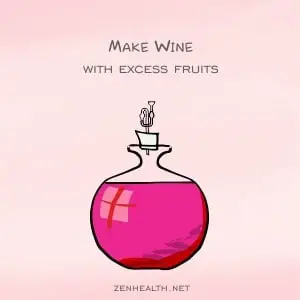
#84. Smoke food
Smoking meats and fish is common throughout the world. Smoked herring and salmon are very popular in Caribbean cuisine. The smoke acts as an antimicrobial agent but it does not penetrate deep enough to preserve food. That’s why it is combined with other preservation techniques like drying or salting.
#85. Try salting
Salting is one of the oldest ways to preserve food. The salt removes moisture and creates an inhospitable environment for pathogens (that’s why brine is a common pickling agent).
Fish and meat are often salted; but you can do it with veggies too like cabbage. Take a look at this Youtube video from The Do It Yourself World. It explains how to salt and cure fish fillets. It’s worth a look!
#86. Use food scraps to make broth
Save all your veggie odds and ends, bones and meat scraps. Keep them in the freezer. And when you have the time, make broth with them. Bone broth, chicken broth, veggie broth, anything!
Throw the scraps in a pot, add 2 parts water, and your choice of seasonings, salt and pepper. Cover and let simmer on low heat for an hour. Remove the scraps, bottle the broth or use it immediately in your soups, stews and more. Freeze some for later too.
#87. Or vinegar
If you’re making apple pie, save the cores and peelings to make your own homemade vinegar. Niamh did a lovely job explaining how she made scrap apple vinegar in her Youtube video. You can use other fruit bits too like strawberry tops and pineapple skins.
[Back to tip #97: DIY cleaning agents]
#88. Talk to your vet
If your pets are anything like my forever hungry although she just ate Rottie, then they can help you with your food scraps. But, before you let them have everything, talk to your vet first. Some foods are just not fit for dogs and cats. Keep a list nearby so you know what they shouldn’t have. Also, with more food, your pets may need more exercise to maintain a healthy weight.
Meat scraps are my pupper’s favorite! She also loves watermelon and eats it with such etiquette! Haha!
#89. Find pet owners or shelters
If you don’t have pets, then talk to nearby pet owners. Ask them if they’d be willing to accept food scraps. Not everyone will be willing; but it doesn’t hurt to ask.
Contact pet shelters too. And request guidelines on the type of food they accept (hopefully it’s not only kibble!).
#90. Or small-scale farmers
Find small-scale farmers or anyone with goats, pigs, chickens, rabbits and ducks. Ask them if they would be open to taking your food scraps. Hopefully, yes! Or if you have the space, consider getting one of these animals. Chickens will give you eggs and pigs even eat bones!

#91. Save the liquid for the garden
Tip #60 looked at saving whey to make bread, pancakes and caramel. Or saving aquafaba to replace eggs. But if you can’t find uses for these liquids, consider saving them for the garden. Let them cool off first, you don’t want to scald your delicate plants.
Liquids used to cook organic grains and pulses are perfect for the garden. Leftover cold coffee and tea won’t hurt the plants either. Diluted pickle juice works great too. And undiluted acidic pickle juice can kill weeds!
#92. Turn your scraps into fertilizer
Grind your eggshells and sprinkle them in the garden as a calcium additive. Use coffee grounds to repel pesky insects. If I’m not making coconut flour (in tip #65), I like to sprinkle the coconut pulp throughout the garden. You can do the same with pulp from your juices, smoothies, and nut and seed milks.
Blend fruit and veggie scraps with water and pour the mix near to the roots of your plants. The mix acts like instant compost. If you are worried about pests, mix in some coffee grounds.
#93. Compost
I compost the old fashioned way by adding food scraps to the garden and covering with soil. A couple months later, I’ll plant veggies and herbs in those spots. Sometimes, I’ll bury scraps near the roots of trees too.
But there are a lot more composting options, even if you have less space. Look at using a compost bucket or a tumbler. Or try vermicomposting and bokashi composting. You will likely find a composting option that works for you!
Be sure to check out Laura’s Youtube video explaining a couple methods of composting.

#94. Or find willing composters
If you are not ready to try composting for yourself, ask around to find nearby composters who would be willing to accept your scraps. Hey, it doesn’t hurt to ask. Talk to the farmers at your local market. Or look for industrial composting facilities in your area.
#95. Enjoy fun scrubs
Use your coffee grounds and pulp to make wonderful face and body scrubs. I love using the bits from making coconut oil on my skin – they are a little rough and still have coconut oil in them.
Mix together coffee grounds, coconut oil and sugar for a nice exfoliant. Try adding honey to almond pulp for a gentler scrub. There are so many scrub possibilities heh!
#96. Use your seed oils
In tip #57, I talked about making your own oil. And I mentioned you can save your sunflower, watermelon, tomato and cucumber seeds to do this. Many of these oils are rich in linoleic acid which is great for protecting and repairing skin (according to this 2017 study).
Use them as body oils to moisturize and hydrate your skin. And be sure to keep them in the dark or in the fridge when you aren’t using them (from tip #35).
#97. DIY cleaning agents
Keep your citrus peels to make your own cleaning agents! If you add the peels to a bottle of white vinegar, the smell will infuse into the acid. Dilute the vinegar and use it to clean your fridge (tip #20), your kettle, and even your leather couch. Oh and use your scrap vinegar too (from tip #87)!
#98. Convince others
You’ve done what you could to reduce food waste… Now what?
For starters, convince those around you to join you on your low waste journey. Share your tips and tricks. Share your food and recipes. Invite them over for a demo. A little goes a long way.
#99. Advocate
This takes convincing others a step further. Advocate! Educate. Engage companies to learn what they plan to do to reduce food waste. Get your friends to join in too. With more customers confronting companies on their food waste policies, they are likely to change.
Kroger in the US saw a 9% drop in its supermarket food waste footprint. And supermarkets across the world are moving towards selling produce in the nude, free of plastic packaging. Talk to your local politicians too. The more voters advocating to reduce food waste, the more likely they will pay attention and maybe… just maybe… do something.

#100. Share this post
Ok, ok… shameless plug I know. Still! Save this post for later. And share it with your nearest and dearest. If everyone can do their part to reduce food waste, we’ll all be better off for it.
There are many more ways to reduce food waste. What do you? Share in the comments … Let’s all learn together :).

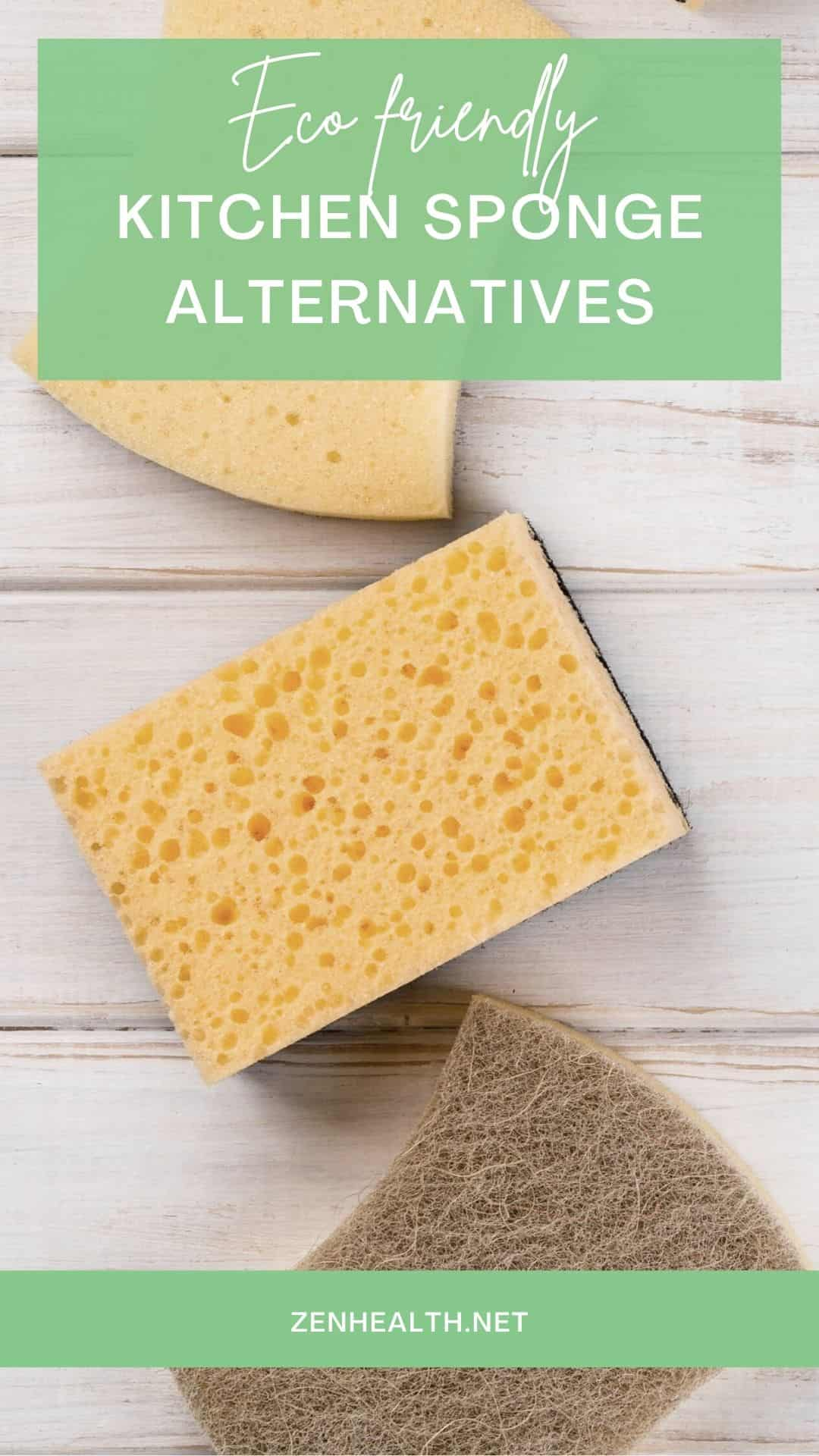


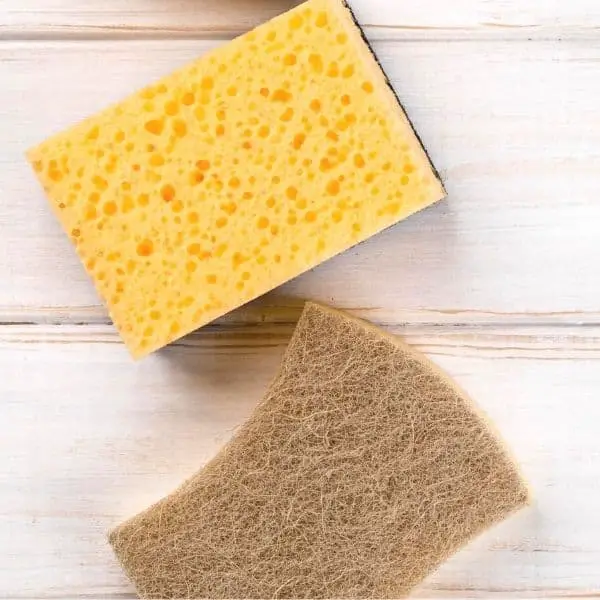
WOW, this post is incredible! I’m sure there is every food-waste reducing tip that I will ever need here, and I can’t think of a single thing to add. I am absolutely saving it for later – it’s like an encyclopaedia (plus there’s no way I’ve remembered everything). Thank you so so much for sharing – I am positive this will help a lot of people!
Aww thanks so much Naomi 🙂 It’s like your second hand September post!
What a fabulous resource of tips to reduce food waste. Under “donate” I would recommend the Olio app which is worldwide and not only can you donate but you can also save branded products going to landfill. I have used it a few times since signing up and am very impressed with the products I’ve had like vegan mayo, stock cubes and even fresh garden produce! Thanks for adding my Vegan Apple Meringue:-)
Sounds like an interesting app Camilla! Will check it out 🙂
These are absolutely incredible tips, and there’s definitely something in here for everyone. I always plan my meals quite thoroughly (food blogger life) so we rarely have any waste these days, unless something has gone bad far quicker than expected. Looking at what you need and not just buying on repeat is one of the best things too x
Sophie
http://www.glowsteady.co.uk
You did a stellar job with this list of tips, Ros! I have learned so much from this article. I’ve definitely been guilty of buying food and then forgetting about it. And who knew to keep potatoes away from onions?! Thank you for this post. I will keep it and share it.
http://lizzyslatest.com/
Thanks Lizzy <3
This is such a brilliant – and well-timed! – blog post and you’ve provided tons of brilliant tips. In particular, tracking what we toss is a fabulous suggestion, to avoid doing it again in future 🙂
aglassofice.com x
Great post dear!! Good job!
Have a lovely day! xx
La ilusión de Nina – https://lailusiondenina.blogspot.com/